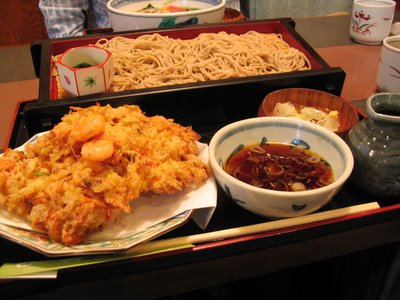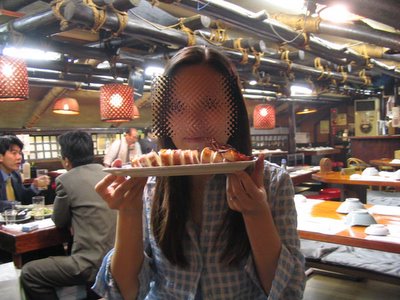| Day Five (Wed): | Ichinoyu Honkan - Sounji Temple - Odawara Castle - Nijubashi (Imperial Palace) - Yurakucho - Ginza - Shinjuku |
| Breakfast: | Traditional Ryokan breakfast Ichinoyu Honkan, Tonosawa, Hakone |
| Lunch: | Handmade Soba at a 150-Year-Old Specialist
|
| Dinner: | Izakaya Below the JR Tracks...pop quiz: what's a chicken wing gyoza? Shin Hinomoto, Yurakucho |
Odawara Castle and Sounji Temple
We would return to Tokyo in the afternoon, but not before visiting the historic town of Odawara.
Breakfast was served at the dining hall again, and consisted of the usual Japanese breakfast items such as Saba Shioyaki (grilled salted mackerel), pickled vegetables, and Natto on rice. I forgot to take a photo.
We visited the historical sites of Sounji and Odawara Castle to pay tribute to the Odawara Hojos and Toyotomi Hideyoshi of the Sengoku era. The most powerful sight in the Sounji temple was in a section missed by many tourists. Deep within the burial grounds, the five once-powerful rulers of the Hojo clan laid together in silence, each occupying no more than 3 square meters of real estate.
If you ever try to get to Sounji on foot from the Hakone Yumoto station, DO NOT take the so called "Chikamichi" (short cut) as the sign tells you. It's no shorter than the longer road (turn left after the red bridge) and it was a unnecessary uphill climb followed by a steep downhill path.

The reconstructed Odawara Castle, although no Himeji, was a very nice photo-op on a sunny day. The perfectly-square stone base, white plaster walls, and dark ornate roofline all made for great shots. There was also a Chrysanthemum competition outside the base of the castle, and of course the sad elephant, and the caged monkeys constantly chasing each others' tails.
We had to catch a 12:47PM train back to Shinjuku, and so decided to go for an early lunch at a generations-old local establishment.
Gourmet Spot #9: Handmade Soba at a 150-Year-Old Specialist - Hashimoto, Odawara

I knew it was old but I didn't know it was that old until I saw the wooden sign (top right). Queen Victoria was a young woman when this place first opened.
My idea of a traditional soba meal was cold soba on a bamboo tray and tempura made with seasonal local ingredients. But my wife surprised me when she decided to order hot soba in a broth, served with an ingredient from far away:

Oysters from Hiroshima! I thought that was probably a mistake, until I tried one bite of the oyster...
The entire oyster was very, very juicy and soft. And very fresh. That was the surprise highlight of the meal! I thought I could *taste* the sea water of Hiroshima through the oyster. Not a traditional soba dish, but I thought it was more spectacular than my more conservative dish of...

Kakiage (mixed tempura patty) and cold Zaru Soba. There were so many shrimps that some of the shrimps weren't even covered by the tempura patty. The tempura was slightly oily and wouldn't be as terrific as Funebashiya's (see Day 7) at Shinjuku. But still a very delicious and filling meal.
| Bill for two persons: | |
| Kake Soba with Hiroshima Oysters | 1050 yen |
| Kakiage Tenseiro | 1260 yen |
| (tax inclusive) | |
| Total | 2310 yen |
Yurakucho
We returned to Shinjuku riding the non-Romance-Car Odakyu train, which stopped at a lot of places despite its Tokkyu (express) designation. After checking in at Shinjuku Washington again (this time we got a newer, non-smoking room), we hurried to the Tokyo Station to take some pictures of Nijubashi bridge at sunset. We merrily snapped photos along the way and ended up at Yurakucho just in time for an early dinner.
Anyone who has been to Yurakucho in the evening rush hour can tell you about the sea of salarymen crowds pushing through the narrow pavement, right beside the lanterns of udon stands and fortune tellers underneath the roaring train tracks. In an impressive display of Japanese space utilization mastery, the whole area under the tracks has developed into an ecosystem of little eateries and miscellaneous businesses that gradually wake up every evening. Hungry middle-aged men in suits would squeeze into these tiny and dimly lit establishments for a few skewers of Yakitori and beer.
Unfortunately most weren't open when we got there at 6:30PM, and those that were didn't look very enticing. In the midst of our search my wife stopped me - her sense of smell had guided us to the dirty outlet of a kitchen fan.
Gourmet Spot #10: Chicken Wing Gyoza Under the Train Tracks - Shin Hinomoto, Yurakucho

That kitchen fan belonged to a split level Izakaya right underneath the JR tracks. It was like a big tent/cave in there, a typical downtown drinking place with an atypical feature...an English (not just English-speaking!) guy managing the place. The guy was about as stand-out as you can get in a Yurakucho Izakaya: white, bald and standing extremely tall beside his dark-haired clients, with whom he chatted and joked in fluent Japanese. It was too early for the normal Izakaya crowd and so it wasn't at all crowded.

My wife's favorite, the Yaki Ika. As mentioned on Day 4, we missed a chance to order one from a street-stall at Hakone Machi, so we made up by ordering this huge one. The smell and taste of the char marks was so wonderful at the end of a long walk.

Suzuki Shioyaki (broiled salted sea bass). The meat was a little too dry for my taste, but the crispy skin was pretty good. Oh well, not every Izakaya can do both perfectly every time.
The next dish was a mystery. My wife wanted Gyoza, and on the menu there's something called Teba Gyoza, which literally means chicken wing dumplings. Now what the heck is a chicken wing dumpling?
Normally, when I consider a Gyoza, it's a minced meat or vegetable filling wrapped inside a thin piece of dough. Typical fillings are pork, chicken, beef, hakusai etc, and chicken wing meat certainly wouldn't look out of place. Since it's a filling wrapped in a piece of Gyoza dough, it's the dough that is the constant. The dough makes a gyoza a gyoza.

But this was totally backwards! This is a Gyoza in the exact opposite definition -- that the filling, not the dough wrapping, makes a gyoza a gyoza. It was the traditional Gyoza filling of minced pork and hakusai wrapped inside a bone-removed, charcoal broiled chicken wing. Unbelievable...
And the taste was amazing of course. How could a lover of Japanese food resist a Gyoza with a tender, juicy filling, and whose wrapping was a boneless, slow charcoal-grilled wing?
| Bill for two persons: | |
| Yaki Ika | ~700 yen |
| Suzuki Shioyaki | ~500 yen |
| Teba Gyoza | ~600 yen |
| Lemonade Chuhai | ~400 yen |
| (apply 5% tax) | |
| Total | ~ 2300 yen |
Kyohou Grapes
After dinner we wandered over to the classy Ginza, but of course we were too poor for the Bally shoes and Ferragamo scarves (having spent much of our budget on food). We took a long stroll back to the Tokyo Station area looking for some Monjayaki, but my wife was already too tired and so we rode the Yamanote back to Shinjuku.

But before returning to the hotel, we bought these wonderful Kyohou Grapes from the food market of a department store basement. Kyohou is a area in the Nagano Prefecture known for its top quality grapes. *Sweet like candy* and very juicy and soft. It wasn't cheap though at 700 yen.
Tidak ada komentar:
Posting Komentar